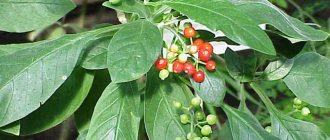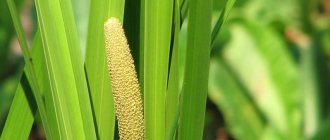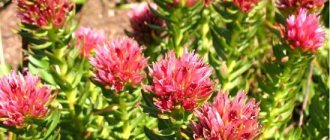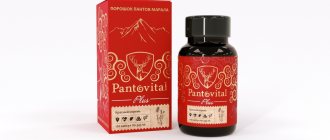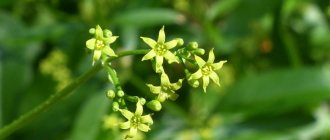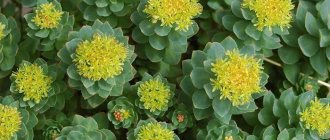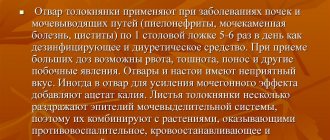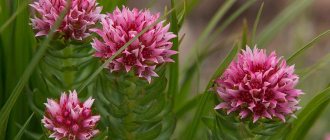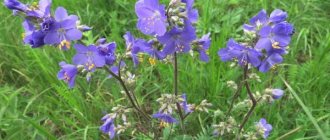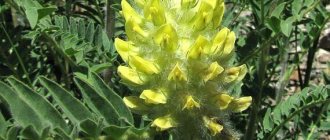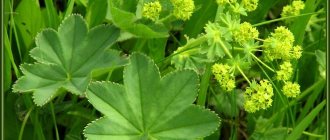Tea kopechnik (forgotten, alpine) is a medicinal plant listed in the Red Book, belongs to the genus Kopeechniki from the Legume family. It grows mainly in mountainous areas, preferring rocky slopes of the subalpine zone. Distributed in Altai, Siberia, the northern side of Mongolia, China, and the Central Asian republics.
The grass has almost bare stems with crimson or lilac racemose inflorescences. Honey-bearing flowers appear in early summer, and by the end of July fruits - dry beans - are formed. Paired oval-shaped green leaves are located at the base of the stems. Adult representatives of the species grow 30-80 cm in height, and the powerful rhizome goes 3-7 meters into the ground.
Alpine pennyweed (Hedysarum alpinum)
Forgotten pennyweed (Hedysarum neglectum)
The fruits of the forgotten kopeck (not eaten)
For its bright color and healing qualities, the plant was called red, bear and male root. In the article we will tell you what medicinal properties alpine kopek has, and we will describe its beneficial and harmful qualities. Let's consider methods of application in medicine.
Medicinal and beneficial properties
The red root, the medicinal properties of which are still being studied, is used in pharmacology and folk medicine to make alcoholic tinctures, decoctions, powders, and tablets against a number of diseases.
The use of drugs based on it is beneficial for the body:
- Normalizes blood pressure with a slight increase.
- Stimulates blood flow and prevents thrombus formation.
- Liquefies mucus and facilitates elimination.
- Stops hemoptysis in tuberculosis.
- It has an antipyretic effect in inflammatory diseases of the respiratory organs caused by cold and flu viruses.
- Calms the nervous system, helps fight stress, depression, apathy.
- Cleanses the blood and liver from toxic compounds.
- Participates in the formation of new blood cells.
- Helps increase the endurance of the heart muscle.
- Tones and strengthens the intestinal muscles, preventing rectal prolapse.
- Improves peristalsis, eliminates spastic pain, relieving inflammation in the gastrointestinal tract.
- Normalizes stool.
- Accelerates recovery from diseases of the urinary system.
- Active in the treatment of oncopathologies.
- It has a positive effect on the female and male reproductive system, helps get rid of infertility, cure a number of disorders of the pelvic organs, and increase sexual activity of both sexes.
- Strengthens the immune system.
- Due to the content of antioxidants, it slows down age-related changes and ensures rapid tissue regeneration.
An extract from flowers, shoots, and leaves of the plant is occasionally used in cosmetology, but the main beneficial properties of the red root are concentrated in the underground part of the same name.
Other effects of alcohol tincture
In addition to the above indications, instructions for use of red root tincture include the following effects and indications:
- regulation of urine secretion;
- maintaining hormonal balance in the body;
- normalization of nervous system function;
- elimination of diarrhea;
- treatment of anemia;
- increasing physical endurance.
The high content of vitamin P, which is beneficial to the body due to its antioxidant properties, provides a positive effect of the tincture on blood vessels and improves their permeability.
Thus, tincture of pennywort helps in the treatment of leg ulcers, varicose veins, bleeding hemorrhoids and certain types of tumors.
The medicine is not addictive! Not suitable for children!
Contraindications and possible harm
Products based on pennywort have contraindications:
- Individual intolerance.
- Acute cardiac, liver or kidney failure.
- History of myocardial infarction.
- Pregnancy.
- Breast-feeding.
- Traumatic brain injury.
- Thrombophlebitis.
- Acute cholecystitis.
- Severe mental illness.
- Alcohol addiction (for alcohol tinctures).
- Chronic arterial hypertension (with blood pressure above 160/100 mm Hg).
- Childhood, adolescence.
The fruits of the tea plant (not eaten)
The components of the plant actively interact with various types of antibiotics, enhancing the effect. To avoid negative reactions, coordinate the simultaneous use of medications and red root with your doctor.
With a slight overdose of Siberian herb, as with long-term use, significant harm is caused to the body.
Violation of the rules of administration causes side effects:
- Insomnia.
- Nervous excitability.
- Anxiety.
- Unreasonable irritability.
- Swelling.
- Hepatic, renal colic.
- Allergic rash.
- Angioedema.
- Migraine.
If symptoms occur, seek emergency medical attention.
Sometimes tea kopeck is mistaken for Korean red ginseng root, but the appearance, benefits and harms of these plants are different. They do not belong to the same genus or family.
Features of use for men and women
The composition allows the red root to be used in gynecology and andrology. It copes with reproductive dysfunctions.
Benefits of herbs for women:
- Eliminates uterine bleeding.
- By normalizing hormonal levels, it reduces nervousness.
- Helps with infertility, replenishes the lack of estrogen.
- Prevents osteoporosis that occurs during menopause.
- Stabilizes a woman’s condition during menopause, reduces the frequency of hot flashes.
- Helps cure erosion, endometriosis.
- Eliminates vaginal dryness, stimulates secretion.
- Restores the menstrual cycle.
- Prevents prolapse and prolapse of the uterus by strengthening smooth muscles.
- Prevents the formation of myomas and fibroids.
- Actively fights cancer cells in breast cancer pathology.
- Helps with mastitis.
- Positively affects skin condition.
- Prevents hair loss.
- Increases sexual desire.
It’s not for nothing that kopeck is called a male root - its use is useful for representatives of the stronger sex suffering from ailments of the genitourinary system.
Indications for use of red root for men:
- urethritis;
- BPH;
- urinary retention;
- erectile disfunction;
- infectious diseases accompanied by inflammation and acute pain;
- infertility.
Kopechnik increases blood flow to the genitals and increases the desire for physical intimacy. However, use as an aphrodisiac must be approved by a physician. He will establish a dosage regimen and determine the dosage.
Chemical composition
The benefits of red root are provided by bioactive compounds in the composition. Chemical analysis of the rhizome of the pennywort showed the concentration of the following substances:
- Estrogen is a steroid sex hormone produced by the ovarian follicles in women and the testicles in men. Responsible for the full development and functioning of the genital organs.
- Flavonoids are plant pigments that provide the rich color of the root. They improve the elasticity of red blood cells, slow down blood clotting, strengthen the walls of capillaries, and have antispasmodic properties.
- Catechins are substances that belong to the class of flavonoids. They have antitoxic and antitumor effects.
- Saponins are organic compounds that accelerate the penetration of proteins through cell membranes. They are diuretics and promote rapid absorption of drugs. They have an antisclerotic, antiulcer, laxative effect.
- Xanthones are powerful plant antioxidants. They prevent mutations in the DNA chain, are able to relieve inflammation, and have an antimicrobial and antitoxic effect. Strengthens the cardiovascular system.
- Tannins are astringent compounds that have disinfectant properties. They help eliminate diarrhea and normalize intestinal microflora.
- Coumarins are organic elements with antitumor activity. Strong anticoagulants, relieve spastic pain.
The red root contains ascorbic acid, as well as a number of macro and microelements:
- iron;
- magnesium;
- calcium;
- potassium;
- zinc;
- manganese;
- selenium;
- strontium, etc.
Pharmaceutical products, release form
Pharmacies offer products where penny is an active ingredient. There are several forms of release:
- pills;
- capsules;
- powder;
- alcohol solution for oral administration;
- tea;
- herbal collection;
- balm.
All of the above products are considered dietary supplements. Despite their healing properties, they are not officially a medicine, although they are recommended by medical practitioners.
Popular and effective preparations based on tea pennyweed:
- tincture "Effex Red Root";
- balm “Tales of Altai”;
- Milona-5 tablets with phytocomplex for women;
- tablets "Milona-11" for men's health;
- tea drink “Kopeechnik”;
- capsules.
Evalar, one of the leading manufacturers of dietary supplements on the domestic pharmacological market, specializes in the production of such products. The company's products have 90% positive reviews.
You can buy dietary supplements without presenting a prescription, but in order not to harm yourself, you should first obtain medical advice and instructions for use. The dosage, frequency of administration, and duration of treatment depend on the initial diagnosis, release form, and the amount of active substance in the drug.
Pharmacological properties
- The symbiosis of active compounds in the composition has an antiviral effect, effectively copes with influenza, colds, herpes type 2, and urinary tract infections.
- Red root has immunomodulatory, antioxidant, anticoagulant, and antibacterial properties.
- Prevents congestion in the prostate gland and promotes its disappearance.
- Prevents the development of inflammation in the bladder. Ensures complete emptying and reduces the frequency of the urge to urinate. Due to this quality, it is used in complex therapy of prostatitis and enuresis in adults.
- Improves blood circulation in the pelvic area, which helps increase potency in men. Normalizes hormonal levels, eliminates disorders of the reproductive system, increases the ability to conceive.
- Stimulates the functioning of the heart, respiratory organs, and central nervous system.
Use in folk medicine, recipes
Red root was used by healers to treat and prevent many ailments. Thanks to traditional medicine recipes, it is possible to prevent and cure pathologies of various organs.
Cardiovascular disordersKopeck is effective against dropsy of the heart, rheumatism, deep vein thrombosis. If there is a hereditary tendency to diseases of the blood vessels and heart, it is worth thinking about preventive measures. An herbal infusion is considered an effective remedy.
To prepare you will need:
- kopeck tea root – 2 tbsp;
- currant leaf – 2 tbsp;
- peppermint – 2 tbsp;
- marsh wild rosemary - 2 tbsp;
- water – 500 ml.
Preparation:
- Mix all the herbs and put them in a thermos.
- Pour boiling water over it.
- We insist 12 hours.
- We filter.
The infusion should be drunk warm, ½ cup 4 times a day.
Pathologies of the respiratory system For influenza, pneumonia, bronchitis, and colds, pennyweed liquefies viscous secretions, facilitates expectoration, and accelerates the transition from a dry cough to a productive one. Stopping hemoptysis in pulmonary tuberculosis.
Decoction recipe:
- Place 15 g of crushed root in an enamel bowl and add 300 ml of warm water.
- Cover with a lid and place in a water bath for half an hour.
- Strain and add a little boiled water to get the original volume.
- Bring to a boil.
Drink 2 tablespoons of the cooled product. 3 times a day before meals. Store in the refrigerator for up to 3 days.
Diseases of the male genitourinary system For urethritis, prostatitis, pain during erection or ejaculation, alcohol-based products are most effective. The most prescribed drug is the “Red Root Plus” tincture from Evalar.
The active components are pennyweed in combination with knotweed herb. This complex has a diuretic effect, slows down the absorption of salts, relieves inflammation and swelling.
Red root tea
To gain a supply of vigor, replenish energy and physical strength, it is recommended to drink a tea drink made from red root. According to legends, bears dug up and ate kopeks to restore strength after hibernation.
Prepare the healing infusion:
- Mix 1 tbsp. dry crushed root and 1 tsp. black tea leaves.
- Pour 400 ml of boiling water.
- Let it sit for 20 minutes.
- Add sweetener.
Instead of black tea, green tea is suitable. It is recommended to drink twice a day, 7-10 days.
Decoction recipe
Make herbal infusions only in a water bath, otherwise half of the nutrients will be lost. We offer a recipe widely used in folk medicine for the prevention of malignant and benign tumors.
Preparation:
- Fill a saucepan with water and place it on the stove.
- Pour the grass into a large enamel bowl and add 1 liter of water.
- Place in a water bath and cover tightly with a lid.
- Simmer over low heat for 40 minutes.
- Pour the hot broth into a thermos.
- Leave for 12 hours, strain, cool.
The resulting product is suitable for washing, douching, and enemas.
Red root tincture with vodka
Method for preparing homemade tincture.
You will need:
- vodka 40% - 0.5 l;
- dried kopeck root - 2 tbsp.
Cooking method:
- Pour the prepared raw materials into a dark glass bowl and fill with vodka.
- Close tightly with a nylon lid and put it in a cool, dark place.
- Shake daily.
- After 2 weeks, strain.
If there is no dark glass container, wrap a simple jar with thick cloth so that it does not let in light.
The recommended dose for use is 40 drops diluted in water, 3 times a day before meals. Depending on the nature of the disease, the therapeutic course lasts from 7 to 30 days.
Composition, calorie content per 100 g, glycemic index and nutritional value
After receiving a portion weighing 100 g, the body absorbs 230 kcal . If consumed in the form of syrup with sugar, the value will be much higher.
Analysis of energy value: zero fat content, 0.2 g of protein and from 30 to 65 g of carbohydrates (depending on the form of the product).
Components of a penny:
- vitamin C, mangiferin;
- alkaloids, polysaccharides;
- amino acids;
- tannins, flavonoids;
- hedysaride, microelements.
The glycemic index is 30 , a moderate value that can sometimes cause a slight increase in blood glucose levels.
Do you know how lungwort is useful for women? How to use this plant? Our article will give you answers to your questions.
You can read about the medicinal properties and contraindications to the use of alfalfa in this material.
The benefits and harms of the spice called cloves are discussed in this publication. Find out more!
Features of collecting and procuring raw materials
The collection of roots begins after the seeds appear, when the pennyweed fades. Usually this is mid-August.
There are strict conditions:
- The plant must be mature, more than 40 cm in height.
- Dig carefully, take up to 1 meter of root.
- A new collection can be made in the same place after ten years. During this time, the grass is completely restored.
The collected roots are washed from dirt, cut into long slices, then laid out in a thin layer on plastic film or paper. Dry raw materials outdoors in the shade, avoid sunlight. If this is not possible, a well-ventilated room will do.
After drying, the kopeck is placed in a cotton bag and stored in a dark place for up to 3 years.
Description of the plant
The red root got its name from its huge, up to 10 cm thick, hard rhizome, reaching more than 5 meters in length and having a rich red color. Even preparations made from the root are distinguished by their red color.
It is a herbaceous perennial with paired pinnate leaves consisting of small oval leaflets. The plant blooms from mid-summer to autumn, covered with purple clusters of small flowers. After the flowers fall off, round, coin-like, fluffy fruits ripen on the kopeck plant.
The red root is not widespread outside of Siberia and the Altai region. Even in its homeland they are trying to preserve the rare plant by limiting the collection of roots. Here it is allowed to harvest no more than a third of the rhizomes of one plant every 10 years.
Application in cosmetology, research
In 2021, Italian scientists conducted experiments aimed at identifying the effect of plants from the Kopeechnikov genus on the condition of the skin. The goal is to establish the feasibility of using extracts for the production of cosmetic and dermatological creams.
Based on the results of the study, conclusions were drawn about the effectiveness of using herbal extracts to combat such skin problems as:
- dryness;
- cracks;
- withering;
- cellulite;
- inflammation;
- redness.
A noticeable influence of the geography of legume growth on the content of useful substances was also noted. The highest concentration is observed in the Altai kopeck extract.
What is red root
Forgotten kopekweed is a perennial from the legume family, which can be recognized by its tall (up to 0.8 m), bare or slightly appressed stems, as well as purple-violet flowers. Its main advantage is its powerful multi-headed root, which goes deep into the soil. Distribution area: alpine meadows, pebbles and juniper forests of rivers flowing through Mongolia, Siberia, China. Natural populations survived only at an altitude of 2000 m. The plant is listed in the Red Book.
Getting the red root is not an easy task. Gatherers sometimes even use hand winches. But they try not to damage the third part of it in order to return to its place of growth in 10 years. Botanists from Tomsk University helped the high-altitude guest adapt to the plain. The resettlement turned out to be difficult, since the mountains have specific conditions of light, humidity, and soil types, but acclimatization did not affect the concentration of nutrients in the plant.

